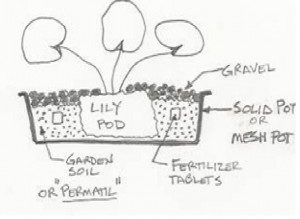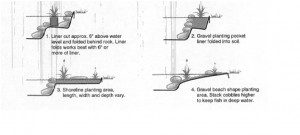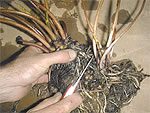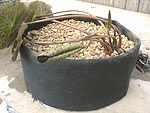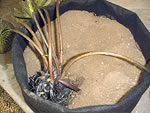Planting Aquatic Plants
Most new aquatic plants need to be replanted into a larger growing environment for best results!
Water lilies: The plant’s crown should be 12 to 24 inches below the water. Water Lilies need to “divided,” or thinned out, every year or two. Most of our Lilies come in an 8 inch pot, which will sustain moderate growth for one summer. Repot them into a 10 to 16 inch wide pot for less frequent thinning, and use Lily fertilizer tablets or spikes all summer for best blooming. Plant in pots only!
Lotus: These large plants need full sun and a large container. The top of the container can be 1 to 18 inches below the water. Lotus “tubers” need to be thinned out, every year in early Spring. They grow in 18 to 24 inch wide pots with only about 3 inches of top soil in the bottom (no gravel). Use Lily fertilizer tablets or spikes all summer for best blooming. Plant in pots only!
Submersibles: These are clump-growing grass-like plants often called “oxygenators” that are planted on the bottom of the pond to help with water clarity and fish “hiding” and spawning places. Plant in pots or in gravel.
Shallow-water Plants: The plant’s crown should be submerged 0 to 4 inches. (Some plants need to have their crown 1 to 2 inches above the water.) Most of our shallow-water (Marginal) plants come in 4 to 6 inch pots and need to be replanted into a larger growing area in the pond or pots for best growth and better support.
Four Planting Methods
(1)Top Soil-Potting (Solid Pots only):
Never use organic or artificial “potting soils” for plants in the pond. Soil should be top soil, or even clay, from the garden. Not compost! Use gravel on top to hold in the soil when submerged. With soil-potting, always use “solid pots”, which have no holes. The most common sizes are 16” x 7” or 10” x 6”. After potting, gently “ease” the pot into the pond to allow the pot to slowly absorb water, and then place the pot in its final position.
(2)“Soil-less” Potting
(Mesh or Solid Pots):
Instead of soil, consider using a soilless aquatic planting granular mix, such as Permatil pebbles, or “Calcined Clay” products. These tiny rocks are a great rooting media for plants and do not cloud-up the pond water as soil does.
Potting plants with Permatil or calcined clay is done just as one would pot in soil, using “solid” nursery pots, or using “mesh pots”, which are perforated on all sides, allowing the pond water to freely contact the plant roots without allowing any potting media to escape. Mesh pots come in several sizes and shapes, including a “kidney-bean” shape for narrow shelves. This technique improves growth, as the plant is more efficient at absorbing nutrients (nitrates) out of the water. This can result in less algae!
Using a thin layer of larger, decorative gravel on top of the pot is still recommended to add weight to the container and to hold the light-weight pebbles in. Fertilizer tablets should still be used as with regular potting methods on Water Lilies and Lotus.
Note: When the plants need dividing or repotting, the mesh pot will not be reusable, as the vigorous root system will penetrate the mesh perforations.
(3) Floating Islands; these unique planters use plain potting soil (or Calcined clay/Permatil pebbles mixed with potting soil) and allow aquatic plants to grow freely, and cleanly without being disturbed by fish. Even large Koi cannot destroy these plants! This is especially helpful for ponds without planting shelves! Be sure to use a wider planter for tall growing plants. Taller plants should be centered in the island to maintain balance. Fertilizer tablets should be used when potting with the “mix”.
(4) Direct pond planting; (For ponds with rocks and gravel inside the pond)
This common technique requires shallow “shelves” in the pond and involves planting shallow-water plants directly into the gravel inside the pond using additional gravel or Permatil pebbles. The roots will grow hydroponically in the gravel without pots. This is how South Pleasantburg Nursery plants most of the ponds we build, including our display pond at the nursery. See below for a few guidelines on this popular planting method.
Some Direct Pond Planting Guidelines:
Some of the “soil” on the plants “root-ball” can be gently removed prior to planting into the gravel to avoid clouding the water.
Plants that will need very little or no maintenance with this method-
Acorus, Alsima, Asclepias*, Arrow Arum, Arrowheads, Hardy Ground Orchid*, Blue Star Creeper, Bog Lily (Crinum), Curly Rush, Cardinal Flower*, Creeping Jenny, Golden Club, Marsh Marigold, Pitcher Plants*, Calla Lily, and Rain Lily.
Plants that will need some “pruning”, or occasional separating with this method-
Bacopa, Umbrella Palms, Star Grass, Dwarf Bamboo (Dulichium), Dwarf Cattails, Carex (Sedges),Forget-Me-Nots, Hibiscus, Iris, Mazus, Pickerel Weed, Ranunculus, Spearmint, Water Willow, Bog Bean, and Bulrush (Scirpus), Sword Plant.
Plants to avoid with this method (too invasive! Use pots only)-
Aruno donax reed, Tall Cattails, Chameleon Plant, Celery, 4-leaf & 2-leaf clover, Horsetail, Lizards Tail, Mint, Phragmites reeds, Penneywort, Yellow-Flag Iris, Hardy Canna (Thalia).
*(plants with asterisk need to be planted with their crown slightly above water level.)
Dividing Hardy Water Lilies
Hardy Water Lilies produce “potato-like” tubers and can crowd a small pot very quickly. For the best blooms and best health, it is recommended to divide or “thin-out” the tubers every year or two. (Large 16 inch wide pots can sustain an undivided lily for two years). The best time to divide a lily is in early Spring through mid-Summer.
Simply remove the potted lily pot from the pond and gently remove the lily plant. Wash off any excess soil or pebbles to expose the numerous tubers. Select the most recent (vigorous) tuber of up to 6 inches in length with at least one growth “crown” emerging from the tip and cut off the remaining old tubers.
Repot this select tuber in a pot with the growth tip facing toward the center of the pot and the cut end near the edge of the pot. The growth tip should be slightly elevated above the added soil or pebbles. If soil is used, add a layer of gravel on top to hold the soil in. Do not cover or damage the growth tip. Add fertilizer tablets or spikes (Spring through Summer) and gently slip the potted lily into the pond.


